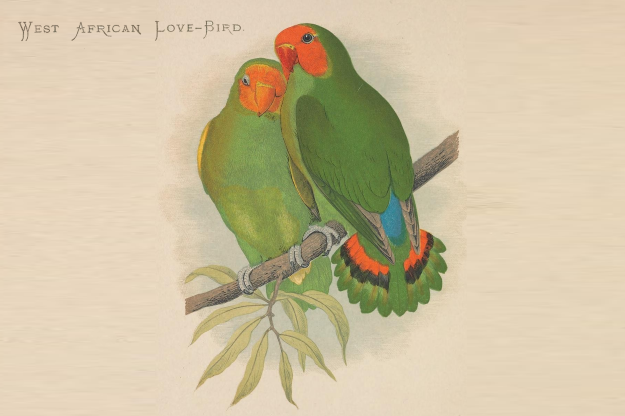Valentine’s Day and Birds
By Jessica Helmbold, ABAS Education Chair
Indiana comedian Jim Gaffigan describes Saint Valentine as the patron saint of overpriced greeting cards. Though in all honesty, who was Saint Valentine and how did the holiday come about? Furthermore, why are birds often depicted in Valentine’s art, and what do they symbolize?
It turns out the Valentine’s Day holiday dates pretty far back and has been celebrated on or around February 14 since its inception. The story begins with some unknown medieval birdwatchers, likely in France, who reckoned that birds begin mating in mid-February. They decided to give this a precise date of February 14. Whether birds really started mating that early in the season is up for debate. The holiday stuck nonetheless.
How the holiday became associated with Saint Valentine is another story. In a society deeply rooted in Catholicism, each day paid homage to a different patron saint. February 14 was dedicated to two Catholic martyrs known as Valentines. Their stories are yet to be fully verified. Likewise, March 17 was dedicated to Saint Patrick and so forth.
What we know about one of the saints, Saint Valentinus of Rome, is that he lived in the third century and was said to have healed a blind woman, the daughter of a non-Christian judge. He was arrested for trying to convert polytheistic Romans to Christianity. He was sent to Rome then under the rule of Emperor Claudius II. He tried to convert Claudius, which enraged the emperor, and Valentinus was executed. Upon his execution, he left a note to the formerly blind girl signed “Your Valentine”.
Why was Saint Valentine associated with February 14? Like many holidays of the time which were pagan, a Christian holiday was incorporated into them to appease the pagans and try to convert them to Christianity. A February pagan holiday was called Lupercalia. This was also the case with Christmas and its pagan counterpart Yule. Lupercalia was similar to Valentine’s Day except more explicit bloody and sacrificial, with the hopes of warding off evil spirits and infertility. Saint Valentine was already considered the patron saint of engaged couples, happy marriages, love, and lovers, and now, beekeeping, plagues, epilepsy, and young people. He is often represented in pictures with birds and roses.
We have now established a connection between Saint Valentine and February 14 and delved into the history of the holiday. Though how did birds play in? In the 1200s, Holy Roman Emperor Frederick II reigned. He was a well-educated man, fluent in six languages, a patron of the arts and sciences, and practiced falconry. He was one of the first Europeans to promote the idea of ornithomancy in his book “The Art of Falconry”. Ornithomancy is the idea of reading omens from birds. It is believed that the first bird a single person sees on Valentine’s Day is a symbol of his or her life partner.
Jeffrey Chaucer, on the subject of birds and love in his poem The Parliament of Foules wrote:
For this day was sent on Valentine’s Day when every fowl is there to choose his mate. Here in nature is convening a parliament at which birds will all choose their mates. The three male eagles make their case for the hand of the female eagle until the birds of the lower estates begin to protest and launch into a comic parliamentary debate which nature to herself, finally ends.
The poem was written to celebrate the anniversary of the engagement of King Richard II to Anne of Bohemia. He was writing a fable to make moral and political points, that the engagement had been strictly a diplomatic affair amidst the 100 Years War. Chaucer was also the first known European to link Saint Valentine with the holiday.
In regards to ornithomancy, more specifically European lore foretold that these bird species would symbolize a future relationship with the following types of individuals.
- Blackbirds: a person of the cloth or a priest. Blackbirds also symbolize a kind person because their black glossy plumage reflects spirituality and charity.
- Bluebirds: a person with a sense of humor, perhaps a comedian.
- Crossbills: a person of argument, such as a lawyer. Not someone you want to “cross”.
- Doves: a kind and loyal, peaceful person and perhaps lifelong partnerships.
- Goldfinches, Yellowhammers, or Yellow Wagtails: a person of riches because of the birds’ gold plumage which symbolizes wealth. Perhaps here in the United States, a Yellow Warbler would also have been included.
- Robins: seafarers.
- Sparrows: country folks or naturalists.
- Woodpeckers: no relationship that year.
- Nuthatches: a person of knowledge. They are very clever, intellectual birds with their upside-down foraging techniques.
- Swans: a person of creativity, whether it be music, visual arts, dance, or theater.
- Canaries: a person of healing. Like the adage of a “canary in a coal mine”, they can often predict when things are in need of healing. These might be doctors or masseuses for example.
- Turkeys: naturalists and environmentalists. Seeing a turkey might even mean you’ll be courting with another birder!
- Birds of Prey: a person in positions of power or leadership. Eagles as an example, also mate for life, so when an eagle is seen it means you are bound to have a stable, life-long relationship.
- Canada Geese: a family man or woman, or someone who is very caring. Canada Geese are lifelong partners and symbolize life-long relationships. Geese are also often caring, helping their young or other injured geese, often staying behind when necessary to aid those injured.
You can see how Medieval Europeans filled the gaps of their knowledge with folklore, using bird sightings for matchmaking. They associated February 14, the day of celebrating love, with the Catholic Saint Valentine and thus created much of what we know as the Valentine’s Day holiday today. You can also see why birds such as doves or bluebirds are often depicted in Valentine’s Day art and greeting cards. It all started in Medieval Europe!

